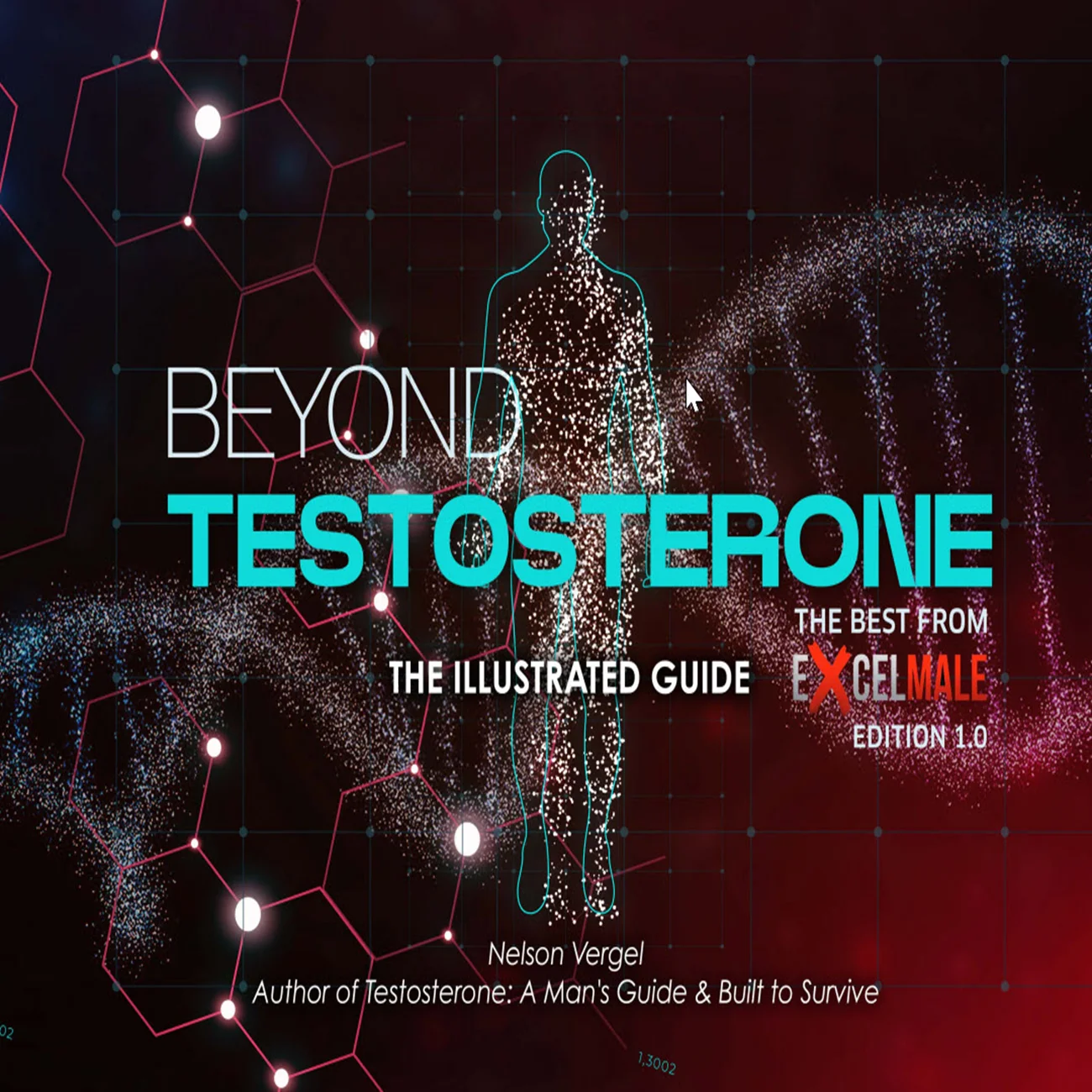Nelson Vergel
Founder, ExcelMale.com
Porn Addiction- Diagnostic Landscape and Controversy
The clinical status of problematic pornography use remains contested. Compulsive Sexual Behavior Disorder (CSBD) is recognized by the WHO in the ICD-11 as an impulse control disorder, but the DSM-5 does not recognize it as a standalone diagnosis. Wikipedia CSBD is characterized by a persistent pattern of failure to control intense, repetitive sexual impulses or urges, resulting in repetitive sexual behavior over an extended period (six months or more) that causes marked distress or impairment in personal, family, social, educational, occupational or other important areas of functioning. PubMed Central
Importantly, CSBD is not classified as an addiction Wikipedia, and legitimate concerns about over-pathologizing sexual behaviors have been carefully addressed in the diagnostic guidelines—mental distress entirely related to moral judgments and disapproval about sexual impulses is not sufficient to diagnose CSBD. PubMed Central
The global incidence rate of CSBD is approximately 5%, with a German study reporting lifetime prevalence of 4.9% in men and 3.0% in women. PubMed Central

Mood, Anxiety, and Depression
The Bidirectional Relationship
The relationship between pornography use and psychological distress appears to be bidirectional and complex:
Research indicates a reciprocal relationship between mood regulation and internet pornography use, suggesting that some people may use pornography to cope with negative emotions, and the use of pornography may manifest in relation to anxiety and depression. PubMed Central
A one-year, three-wave longitudinal study among over 4,300 US adults found that problematic pornography use was positively associated with psychological distress (anxiety and depression) in numerous cross-sectional studies, and these bivariate intercorrelations were strong. ScienceDirect
This study found that problematic pornography use tends to remain stable over time and is strongly associated with psychological distress such as anxiety and depression, suggesting that while some people may experience short-term relief from distress through pornography use, long-term patterns of dysregulation are tied to more persistent psychological difficulties. PsyPost
Pornography as Coping Mechanism
Some findings suggest that internet pornography consumption might represent a defense mechanism against excessive stress, which enables coping with stressful events, helps in mood regulation, and decreases depression and anxiety. However, users also reported that their self-exposition to pornographic material may create guilty feelings and internal conflict with respect to their own "involuntary" sexual behavior. PubMed Central
Respondents indicated that their pornography use exacerbated other mental and emotional issues, especially when they used pornography to ameliorate low mood or loneliness. Paradoxically, this emotional regulation strategy often intensified the underlying problems. Nature
University and Population Studies
In a study of over 1,000 university students, 17.0%, 20.4%, and 13.5% reported severe or extremely severe levels of depression, anxiety, and stress respectively, with compulsive pornography use significantly affecting all three mental health parameters in both sexes. PubMed Central
Sexual Function: Erectile Dysfunction, Libido, and Desire
The Evidence Is More Nuanced Than Popular Claims Suggest
There is little if no evidence that pornography use may induce delayed ejaculation and erectile dysfunction, although longitudinal studies that control for confounding variables are required for a full assessment. PubMed Central
Across all 3 samples studied, there was evidence of a positive, cross-sectional association between self-reported problematic use and ED, but no consistent association between mere use itself and ED. Latent growth curve analyses demonstrated no significant causal relationships between any pornography-related variables and trajectories of ED. ScienceDirect
Claims of a strong relationship between pornography use and sexual dysfunction are generally unfounded, both by the findings of studies and/or by misinterpretations of them. Women were more likely to show positive associations between pornography use and sexual functioning, whereas men showed mixed results. ResearchGate
When Preference Shifts Matter
A study found no association between erectile function scores and craving for, or obsessive passion for, pornography. However, preference for pornography with masturbation over partnered sex was significantly associated with erectile dysfunction—rates of ED were lowest in those preferring partnered sex without pornography (22.3%) and increased significantly when pornography was preferred over partnered sex (78%). PubMed
The Libido Connection
More than half of European heterosexual men who had experienced a significant decrease in libido within six months before examination were involved with pornographic materials at least once a week. Although it is an interesting observation that men with impaired libido may watch more pornography and masturbate often, men with lower sexual desire tend to increase masturbation frequency in a manner unrelated to pornography consumption. PubMed Central
Respondents generally indicated that their pornography use had a negative impact on their sexual health and wellbeing, including reduced sense of connection with sexual partners, as well as reduced libido, ease of arousal, and orgasm functioning. Nature
Rising ED in Young Men
Traditional factors that once explained men's sexual difficulties appear insufficient to account for the sharp rise in erectile dysfunction, delayed ejaculation, decreased sexual satisfaction, and diminished libido during partnered sex in men under 40. PubMed Central
An international web-based survey found that 21.48% of sexually active participants aged 18-35 had some degree of ED. Higher scores indicating problematic online pornography consumption resulted in a higher probability of ED while controlling for covariates. The authors concluded this prevalence of ED in young men is "alarmingly high." PubMed
Neuroscience: Dopamine, Reward, and Habituation
Brain Changes and the Reward System
The drastic worldwide increase of pornography use as sexual stimulation has been discussed to induce erectile dysfunction via alterations in the brain's motivational system (mesolimbic dopamine pathway). Erections depend on dopaminergic neurons in the ventral tegmental area and dopamine receptors in the nucleus accumbens. PubMed Central
Due to the huge amount of pornographic material on the internet, repeated experiences of immense numbers of sexually arousing objects lead to long-lasting arousing emotional experiences that decrease usual mechanisms of habituation. This sensitization related to long-term sexual arousal may have negative consequences for balance between excitatory and inhibitory neural systems, and may cause uncontrolled hypersexual behavior. PubMed Central
Kinsey Institute researchers were among the first to report pornography-induced erectile dysfunction and abnormally low libido in 2007. Half of subjects recruited from venues where video pornography was omnipresent were unable to achieve erections in response to video porn. Researchers discovered that high exposure apparently resulted in lower responsivity and an increased need for more extreme, specialized material to become aroused. PubMed Central
Dopamine Dynamics
Huberman explained that pornography triggers the release of dopamine and short-term increases in testosterone through observation of sex rather than actual human contact. When individuals consume pornography, their brains learn to associate sexual arousal with watching other people have sex—this learned response may not translate to real-life sexual interactions with a partner. Andrew Huberman
Extremely potent stimuli set a high threshold for dopamine release in the brain. The higher the dopamine peak, the bigger the drop afterward, often falling below baseline. This can lead to a cycle of pursuing dopamine peaks through the same activity. Andrew Huberman
Testosterone: What Does the Research Actually Show?
Despite popular claims, the evidence on pornography and testosterone is limited:
Repeated exposure and previous experience of men to pornography have modulated the association of testosterone levels with sexual interest. More prior exposure increased the association of testosterone levels with sexual interest—thus testosterone may act as motivation enhancer when repeated exposure has led to habituation. Springer
Ejaculation can cause an increase in prolactin, which inhibits the release of LH and FSH hormones that can increase testosterone. Daily or multiple daily habits could be particularly detrimental from a hormonal perspective. Huberman Lab
Aside from one older study, there's no other research to indicate that abstaining from masturbation will have any significant or lasting increase in testosterone levels. Healthline
The Role of Moral Incongruence
A significant body of research suggests that perceived problems with pornography are often driven by moral or religious beliefs rather than objective use patterns:
The moral incongruence model posits that religious people tend to think that their sexual behaviors are incongruent with their values, regardless of what those behaviors may actually be. Religious individuals who use pornography—for whom moral incongruence is likely implied—report a diverse range of distressing symptoms associated with their use. ResearchGate
Findings have demonstrated that among those who morally disapprove of its use, even irregular, infrequent pornography use produces intense feelings of distress, namely shame and guilt. The degree to which use is associated with adverse outcomes depends, in part, on the degree to which users self-identify as being addicted to pornography. Springer
Perceived addiction to pornographic use rather than actual use is related to high incidence of feelings of guilt and shame and predicts religious and spiritual struggle. Moral incongruence has a significant association with increased distress about pornography use, enhanced psychological distress in general, and greater incidence of perceived addiction. PubMed Central
The relationship between pornography use and psychological distress is often strongest among men who morally disapprove of pornography yet continue to consume it. Studies suggest that the perception of addiction—rather than actual consumption patterns—often predicts negative mental health outcomes. Psychology Today
NoFap and Abstinence-Based Approaches
Limited Scientific Support
NoFap's views and efforts to combat pornography addiction have been criticized as simplistic, outdated, and incorrect by neuroscientists, psychologists, and other medical professionals. The purported science behind the group's activities is said to come from an Oregon man with no scientific training or background. Wikipedia
While some people report experiencing benefits from adopting the NoFap lifestyle, these claims aren't rooted in much scientific evidence. There's nothing inherently wrong with masturbation, using porn, or masturbating while using porn. Healthline
A July 2024 scientific article by a committee convened by the International Society for Sexual Medicine concluded that they "strongly oppose therapeutic interventions that increase the experience of discrimination, stigma, and moral incongruence. This includes approaches that prohibit unilaterally certain sexual behaviors (e.g., viewing pornography, masturbation), apply an addiction model with notions of abstinence from sexual behavior, or seek to impose the professional's moral or religious values on patients." Ro
Potential Harms
A preregistered survey found that participants reported their most recent "relapse" was followed by feeling shameful, worthless, sad, and a desire to commit suicide. They also reported that NoFap forums contained posts that were misogynist (73.7%), bullying (49.1%), anti-LGBT (42.9%), antisemitic (32.0%), or instructing followers to harm themselves (23.5%). More engagement in NoFap forums was associated with worse symptoms of erectile dysfunction, depression, anxiety, and more sex negativity. Sage Journals
A 2021 qualitative study found that NoFap's approach appears harmful—specifically, commitment to abstinence, framed by notions of recovery and relapse, was found to be a major factor for maintaining distress. Wikipedia
Some Evidence for Abstinence Benefits in Clinical Cases
There have been clinical reports where pornography users were asked to abstain for relief of sexual dysfunctions, including low sexual desire and erectile dysfunction. In most of these cases, abstaining from pornography provided relief from sexual dysfunction, providing preliminary evidence that abstinence could potentially be beneficial for those with problematic pornography use. Springer
Treatment Recommendations
Psychotherapy and cognitive-behavioral therapy are the preferred treatment methods for CSBD. Selective serotonin reuptake inhibitors and naltrexone are commonly used as "off-label" drugs. The diagnosis and treatment should integrate biological, psychological, and social factors with expertise in sexual medicine by employing a comprehensive and holistic approach. PubMed Central
Clinical sexologic and sexual medicine expertise for diagnosis and treatment is imperative. Evidence-based, sexual medicine–informed therapies should be offered to achieve a positive and respectful approach to sexuality and the possibility of having pleasurable and safe sexual experiences. Oxford Academic
Some treatment guides suggest shame is at the core of CSBD mechanism—shame associated with cognitive schema of self-defectiveness functions by making sexual behavior compulsive while excessive behavior causes extra shame, forming a self-sustaining cycle. Therefore, treatment is primarily aimed at shame reduction and social reintegration. Wikipedia
Key Takeaways
The clinical status of problematic pornography use remains contested. Compulsive Sexual Behavior Disorder (CSBD) is recognized by the WHO in the ICD-11 as an impulse control disorder, but the DSM-5 does not recognize it as a standalone diagnosis. Wikipedia CSBD is characterized by a persistent pattern of failure to control intense, repetitive sexual impulses or urges, resulting in repetitive sexual behavior over an extended period (six months or more) that causes marked distress or impairment in personal, family, social, educational, occupational or other important areas of functioning. PubMed Central
Importantly, CSBD is not classified as an addiction Wikipedia, and legitimate concerns about over-pathologizing sexual behaviors have been carefully addressed in the diagnostic guidelines—mental distress entirely related to moral judgments and disapproval about sexual impulses is not sufficient to diagnose CSBD. PubMed Central
The global incidence rate of CSBD is approximately 5%, with a German study reporting lifetime prevalence of 4.9% in men and 3.0% in women. PubMed Central
Mood, Anxiety, and Depression
The Bidirectional Relationship
The relationship between pornography use and psychological distress appears to be bidirectional and complex:
Research indicates a reciprocal relationship between mood regulation and internet pornography use, suggesting that some people may use pornography to cope with negative emotions, and the use of pornography may manifest in relation to anxiety and depression. PubMed Central
A one-year, three-wave longitudinal study among over 4,300 US adults found that problematic pornography use was positively associated with psychological distress (anxiety and depression) in numerous cross-sectional studies, and these bivariate intercorrelations were strong. ScienceDirect
This study found that problematic pornography use tends to remain stable over time and is strongly associated with psychological distress such as anxiety and depression, suggesting that while some people may experience short-term relief from distress through pornography use, long-term patterns of dysregulation are tied to more persistent psychological difficulties. PsyPost
Pornography as Coping Mechanism
Some findings suggest that internet pornography consumption might represent a defense mechanism against excessive stress, which enables coping with stressful events, helps in mood regulation, and decreases depression and anxiety. However, users also reported that their self-exposition to pornographic material may create guilty feelings and internal conflict with respect to their own "involuntary" sexual behavior. PubMed Central
Respondents indicated that their pornography use exacerbated other mental and emotional issues, especially when they used pornography to ameliorate low mood or loneliness. Paradoxically, this emotional regulation strategy often intensified the underlying problems. Nature
University and Population Studies
In a study of over 1,000 university students, 17.0%, 20.4%, and 13.5% reported severe or extremely severe levels of depression, anxiety, and stress respectively, with compulsive pornography use significantly affecting all three mental health parameters in both sexes. PubMed Central
Sexual Function: Erectile Dysfunction, Libido, and Desire
The Evidence Is More Nuanced Than Popular Claims Suggest
There is little if no evidence that pornography use may induce delayed ejaculation and erectile dysfunction, although longitudinal studies that control for confounding variables are required for a full assessment. PubMed Central
Across all 3 samples studied, there was evidence of a positive, cross-sectional association between self-reported problematic use and ED, but no consistent association between mere use itself and ED. Latent growth curve analyses demonstrated no significant causal relationships between any pornography-related variables and trajectories of ED. ScienceDirect
Claims of a strong relationship between pornography use and sexual dysfunction are generally unfounded, both by the findings of studies and/or by misinterpretations of them. Women were more likely to show positive associations between pornography use and sexual functioning, whereas men showed mixed results. ResearchGate
When Preference Shifts Matter
A study found no association between erectile function scores and craving for, or obsessive passion for, pornography. However, preference for pornography with masturbation over partnered sex was significantly associated with erectile dysfunction—rates of ED were lowest in those preferring partnered sex without pornography (22.3%) and increased significantly when pornography was preferred over partnered sex (78%). PubMed
The Libido Connection
More than half of European heterosexual men who had experienced a significant decrease in libido within six months before examination were involved with pornographic materials at least once a week. Although it is an interesting observation that men with impaired libido may watch more pornography and masturbate often, men with lower sexual desire tend to increase masturbation frequency in a manner unrelated to pornography consumption. PubMed Central
Respondents generally indicated that their pornography use had a negative impact on their sexual health and wellbeing, including reduced sense of connection with sexual partners, as well as reduced libido, ease of arousal, and orgasm functioning. Nature
Rising ED in Young Men
Traditional factors that once explained men's sexual difficulties appear insufficient to account for the sharp rise in erectile dysfunction, delayed ejaculation, decreased sexual satisfaction, and diminished libido during partnered sex in men under 40. PubMed Central
An international web-based survey found that 21.48% of sexually active participants aged 18-35 had some degree of ED. Higher scores indicating problematic online pornography consumption resulted in a higher probability of ED while controlling for covariates. The authors concluded this prevalence of ED in young men is "alarmingly high." PubMed
Neuroscience: Dopamine, Reward, and Habituation
Brain Changes and the Reward System
The drastic worldwide increase of pornography use as sexual stimulation has been discussed to induce erectile dysfunction via alterations in the brain's motivational system (mesolimbic dopamine pathway). Erections depend on dopaminergic neurons in the ventral tegmental area and dopamine receptors in the nucleus accumbens. PubMed Central
Due to the huge amount of pornographic material on the internet, repeated experiences of immense numbers of sexually arousing objects lead to long-lasting arousing emotional experiences that decrease usual mechanisms of habituation. This sensitization related to long-term sexual arousal may have negative consequences for balance between excitatory and inhibitory neural systems, and may cause uncontrolled hypersexual behavior. PubMed Central
Kinsey Institute researchers were among the first to report pornography-induced erectile dysfunction and abnormally low libido in 2007. Half of subjects recruited from venues where video pornography was omnipresent were unable to achieve erections in response to video porn. Researchers discovered that high exposure apparently resulted in lower responsivity and an increased need for more extreme, specialized material to become aroused. PubMed Central
Dopamine Dynamics
Huberman explained that pornography triggers the release of dopamine and short-term increases in testosterone through observation of sex rather than actual human contact. When individuals consume pornography, their brains learn to associate sexual arousal with watching other people have sex—this learned response may not translate to real-life sexual interactions with a partner. Andrew Huberman
Extremely potent stimuli set a high threshold for dopamine release in the brain. The higher the dopamine peak, the bigger the drop afterward, often falling below baseline. This can lead to a cycle of pursuing dopamine peaks through the same activity. Andrew Huberman
Testosterone: What Does the Research Actually Show?
Despite popular claims, the evidence on pornography and testosterone is limited:
Repeated exposure and previous experience of men to pornography have modulated the association of testosterone levels with sexual interest. More prior exposure increased the association of testosterone levels with sexual interest—thus testosterone may act as motivation enhancer when repeated exposure has led to habituation. Springer
Ejaculation can cause an increase in prolactin, which inhibits the release of LH and FSH hormones that can increase testosterone. Daily or multiple daily habits could be particularly detrimental from a hormonal perspective. Huberman Lab
Aside from one older study, there's no other research to indicate that abstaining from masturbation will have any significant or lasting increase in testosterone levels. Healthline
The Role of Moral Incongruence
A significant body of research suggests that perceived problems with pornography are often driven by moral or religious beliefs rather than objective use patterns:
The moral incongruence model posits that religious people tend to think that their sexual behaviors are incongruent with their values, regardless of what those behaviors may actually be. Religious individuals who use pornography—for whom moral incongruence is likely implied—report a diverse range of distressing symptoms associated with their use. ResearchGate
Findings have demonstrated that among those who morally disapprove of its use, even irregular, infrequent pornography use produces intense feelings of distress, namely shame and guilt. The degree to which use is associated with adverse outcomes depends, in part, on the degree to which users self-identify as being addicted to pornography. Springer
Perceived addiction to pornographic use rather than actual use is related to high incidence of feelings of guilt and shame and predicts religious and spiritual struggle. Moral incongruence has a significant association with increased distress about pornography use, enhanced psychological distress in general, and greater incidence of perceived addiction. PubMed Central
The relationship between pornography use and psychological distress is often strongest among men who morally disapprove of pornography yet continue to consume it. Studies suggest that the perception of addiction—rather than actual consumption patterns—often predicts negative mental health outcomes. Psychology Today
NoFap and Abstinence-Based Approaches
Limited Scientific Support
NoFap's views and efforts to combat pornography addiction have been criticized as simplistic, outdated, and incorrect by neuroscientists, psychologists, and other medical professionals. The purported science behind the group's activities is said to come from an Oregon man with no scientific training or background. Wikipedia
While some people report experiencing benefits from adopting the NoFap lifestyle, these claims aren't rooted in much scientific evidence. There's nothing inherently wrong with masturbation, using porn, or masturbating while using porn. Healthline
A July 2024 scientific article by a committee convened by the International Society for Sexual Medicine concluded that they "strongly oppose therapeutic interventions that increase the experience of discrimination, stigma, and moral incongruence. This includes approaches that prohibit unilaterally certain sexual behaviors (e.g., viewing pornography, masturbation), apply an addiction model with notions of abstinence from sexual behavior, or seek to impose the professional's moral or religious values on patients." Ro
Potential Harms
A preregistered survey found that participants reported their most recent "relapse" was followed by feeling shameful, worthless, sad, and a desire to commit suicide. They also reported that NoFap forums contained posts that were misogynist (73.7%), bullying (49.1%), anti-LGBT (42.9%), antisemitic (32.0%), or instructing followers to harm themselves (23.5%). More engagement in NoFap forums was associated with worse symptoms of erectile dysfunction, depression, anxiety, and more sex negativity. Sage Journals
A 2021 qualitative study found that NoFap's approach appears harmful—specifically, commitment to abstinence, framed by notions of recovery and relapse, was found to be a major factor for maintaining distress. Wikipedia
Some Evidence for Abstinence Benefits in Clinical Cases
There have been clinical reports where pornography users were asked to abstain for relief of sexual dysfunctions, including low sexual desire and erectile dysfunction. In most of these cases, abstaining from pornography provided relief from sexual dysfunction, providing preliminary evidence that abstinence could potentially be beneficial for those with problematic pornography use. Springer
Treatment Recommendations
Psychotherapy and cognitive-behavioral therapy are the preferred treatment methods for CSBD. Selective serotonin reuptake inhibitors and naltrexone are commonly used as "off-label" drugs. The diagnosis and treatment should integrate biological, psychological, and social factors with expertise in sexual medicine by employing a comprehensive and holistic approach. PubMed Central
Clinical sexologic and sexual medicine expertise for diagnosis and treatment is imperative. Evidence-based, sexual medicine–informed therapies should be offered to achieve a positive and respectful approach to sexuality and the possibility of having pleasurable and safe sexual experiences. Oxford Academic
Some treatment guides suggest shame is at the core of CSBD mechanism—shame associated with cognitive schema of self-defectiveness functions by making sexual behavior compulsive while excessive behavior causes extra shame, forming a self-sustaining cycle. Therefore, treatment is primarily aimed at shame reduction and social reintegration. Wikipedia
Key Takeaways
- "Pornography addiction" is not a recognized diagnosis in DSM-5, though CSBD (not classified as addiction) exists in ICD-11 for a minority (~5%) with genuine dysregulation
- Causation remains unclear: Most studies are cross-sectional; longitudinal data generally doesn't support causal claims that pornography causes ED or depression
- Problematic use ≠ any use: The key distinction is between regular consumption and genuinely compulsive, distressing patterns
- Moral incongruence is a major confounder: Much distress attributed to pornography may stem from conflict between behavior and moral/religious beliefs rather than the pornography itself
- The NoFap movement lacks scientific support and may actually cause harm through shame, abstinence-failure cycles, and association with extremist content
- Individual differences matter: Some men clearly experience problems they attribute to pornography; for others, moderate use has no apparent negative effects
- Preference patterns may be more important than frequency: Preferring pornography to partnered sex shows stronger association with dysfunction than frequency alone
- Treatment should be individualized, sex-positive, shame-reducing, and based on evidence rather than addiction-model abstinence approaches
Last edited:












